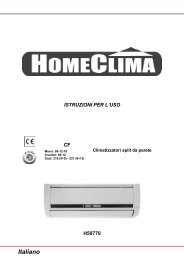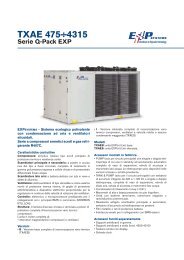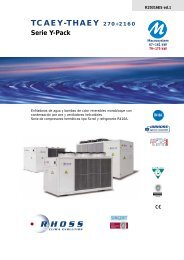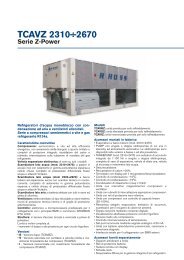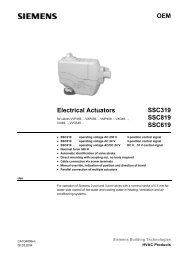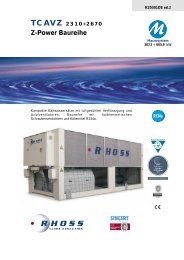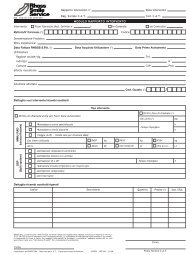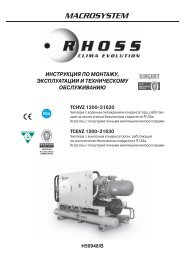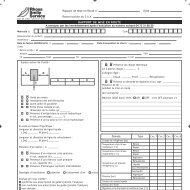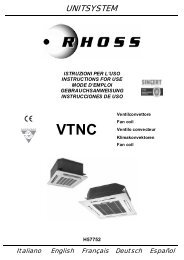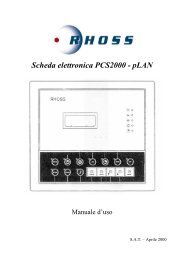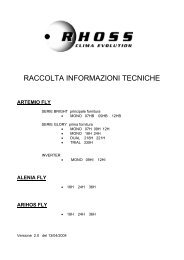H51308-v0A Manuale Istruzioni VTNC - Rhoss
H51308-v0A Manuale Istruzioni VTNC - Rhoss
H51308-v0A Manuale Istruzioni VTNC - Rhoss
You also want an ePaper? Increase the reach of your titles
YUMPU automatically turns print PDFs into web optimized ePapers that Google loves.
SECTION II: INSTALLATION AND MAINTENANCE<br />
II.2.5<br />
WATER CONNECTIONS<br />
II.2.5.1<br />
IMPORTANT!<br />
The water connections are very important and<br />
particular care should be dedicated to these<br />
operations by specialist personnel.<br />
Connection to the System<br />
The water connections are fixed to the structure of the unit so as to<br />
prevent breakage during the connection of the pipes. However, we<br />
recommend holding the connection in place with a spanner.<br />
The top coil connection has an air bleed valve, while the bottom<br />
connection has a drainage valve which can be adjusted using a 10 mm<br />
spanner or a screwdriver.<br />
<strong>VTNC</strong><br />
250<br />
<strong>VTNC</strong><br />
IMPORTANT!<br />
The coil can only be partly drained. For complete<br />
drainage we recommend blowing air into the coil.<br />
The pipes must be covered with anti-condensation material, such as<br />
polyurethane, propylene, neoprene or other expanded materials of 5-10<br />
mm thick. In the case of several units installed in one room, the<br />
condensation collection pipe must be installed as illustrated in the<br />
figure.<br />
Model Ø connections<br />
25 ¾”<br />
30 ¾”<br />
50 ¾”<br />
60 ¾”<br />
85 ¾”<br />
25 - 30 - 50<br />
<strong>VTNC</strong><br />
<strong>VTNC</strong><br />
IN<br />
V2<br />
V1<br />
OUT<br />
II.2.5.3 Creating the Water Siphon<br />
The condensation drainage system must include a suitable siphon to<br />
prevent odours from infiltrating the room. Instructions on how to create<br />
a water siphon are given below.<br />
60 - 85<br />
V2<br />
IN<br />
V1<br />
OUT<br />
50 mm<br />
100 mm<br />
II.2.5.2<br />
IN Water inlet<br />
OUT Water outlet<br />
V1 Air bleed valve<br />
V2 Drainage valve<br />
Creating the Water Drain<br />
For regular condensation drainage, the drain pipe must be tilted<br />
downwards by 2%, with no bottlenecks. There should also be a siphon,<br />
with access for inspection, at least 50 mm down in order to prevent bad<br />
smells entering the environment.<br />
<strong>VTNC</strong><br />
2%<br />
Always include a cap at the bottom of the siphon for cleaning purposes,<br />
or ensure that it can be quickly disassembled.<br />
II.2.5.4<br />
IMPORTANT!<br />
Position the drain pipe so that it does not place any<br />
mechanical stress on the unit drain connection.<br />
Checks<br />
Once installation has been completed, you will need to:<br />
• Bleed the air out of the circuit.<br />
• Make sure that there are no water leaks.<br />
• Cover the valve (if present) and connection pipes carefully with anticondensation<br />
material of 10 mm thick or install the auxiliary trays.<br />
• Pour water into the condensation collection trays and make sure that<br />
the liquid is drained properly, following its course until it leaves the<br />
condensation drain. If this does not occur, check the angle and look for<br />
any blockages.<br />
50<br />
The water can be drained at a maximum of 250 mm above the unit, as<br />
long as the upwards stretch of pipe is vertical and positioned in<br />
correspondence to the drain flange. To drain the water at a height<br />
above the permitted 250 mm, install an auxiliary condensation drain<br />
pump (KMC) with collection tray and level regulator. We recommend<br />
models with a safety float to stop the water flow in the cause of pump<br />
malfunction.<br />
43



